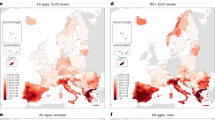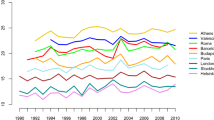Abstract
High ambient temperatures have been associated with increased mortality across the world. Several studies suggest that timely preventive measures may reduce heat-related excess mortality. The main aim of this study was to detect the temporal modification of heat-related mortality, in older adults (aged 65–74) and in elderly ≥75 years old, in the Florentine area by comparing previous (1999–2002) and subsequent (2004–2007) periods to the summer of 2003, when a regional Heat-Health Warning System (HHWS) was set up. Mortality data from 1999 to 2007 (May–September) were provided by the Mortality Registry of the Tuscany Region (n = 21,092). Weather data were used to assess daily apparent temperatures (AT). Case-crossover time-stratified designs and constrained segmented distributed lag models were applied. No significant heat-related mortality odds ratio (OR) variations were observed among the sub-periods. Nevertheless, a general OR decrease dating from 1999–2002 (OR 1.23; lack of HHWS) to 2004–2005 (OR 1.21; experimental HHWS running only for Florence) and to 2006–2007 (OR 1.12; official HHWS extended to the whole Florentine area) was observed when the maximum AT was considered. This modification was only evident in subjects ≥75 years old. The heat effect was higher and sustained for more days (until lag 9) during the period 1999–2002 than 2004–2007. The decrease of the excessive heat effect on mortality between periods with the absence and existence of a HHWS is also probably due to the mitigation of preventive measures and the implementation of a HHWS with specific interventions for safeguarding the health of the “frail elderly”.




Similar content being viewed by others
References
Bassil KL, Cole DC (2010) Effectiveness of public health interventions in reducing morbidity and mortality during heat episodes: a structured review. Int J Res Public Health 7:991–1001
Bland JM, Altman DG (2000) Statistics notes. The odds ratio. BMJ 320:1468
Conti S, Masocco M, Meli P, Minelli G, Palummeri E, Solimini R, Toccaceli V, Vichi M (2007) General and specific mortality among the elderly during the 2003 heat wave in Genoa (Italy). Environ Res 103:267–274
Davis RE, Knappenberger PC, Michaels PJ, Novicoff WM (2003) Changing heat-related mortality in the United States. Environ Health Perspect 111:1712–1718
de’Donato FK, Stafoggia M, Rognoni M, Poncino S, Caranci N, Bisanti L, Demaria M, Forastiere F, Michelozzi P, Pelosini R, Perucci CA (2008) Airport and city-centre temperatures in the evaluation of the association between heat and mortality. Int J Biometeorol 52:301–310
Ebi KL, Teisberg TJ, Kalkstein LS, Robinson L, Weiher RF (2004) Heat watch/warning systems save lives: estimated costs and benefits for Philadelphia 1995–98. Am Meteorol Soc 85:1067–1073
Flynn A, McGreevy C, Mulkerrin EC (2005) Why do older patients die in a heatwave? Q J Med 98:227–229
Fouillet A, Rey G, Wagner V, Laaidi K, Empereur-Bissonnet P, Le Tertre A, Frayssinet P, Bessemoulin P, Laurent F, De Crouy-Chanel P, Jougla E, Hémon D (2008) Has the impact of heat waves on mortality changed in France since the European heat wave of summer 2003? A study of the 2006 heat wave. Int J Epidemiol 37:309–317
Gasparrini A, Armstrong B, Kenward MG (2010) Distributed lag non-linear models. Stat Med 29:2224–2234
Hastie TJ, Tibshirani NJ (1990) Generalized additive models, vol 43. In: Monographs on Statistics and Applied Probability. Chapman & Hall, London
Kalkstein LS, Jamason PF, Greene JS, Libby J, Robinson L (1996) The Philadelphia hot weather-health watch/warning system: development and application, summer 1995. Bull Am Meteorol Soc 77:1519–1528
Kanamitsu M, Ebisuzaki W, Woollen J, Yang SK, Hnilo JJ, Fiorino M, Potter GL (2002) NCEP-DEO AMIP-II Reanalysis (R-2). Bul of the Atmos Met Soc 1631–1643
Kysely J, Kriz B (2008) Decreased impacts of the 2003 heat waves on mortality in the Czech Republic: an improved response? Int J Biometeorol 52:733–745
Levy L, Lumley T, Sheppard L, Kaufman J, Checkoway H (2001) Referent selection in case-crossover analyses of acute health effects of air pollution. Epidemiology 12:186–192
Muggeo VMR (2003) Estimating regression models with unknown break-points. Stat Med 22:3055–3071
Muggeo VMR (2010) Analyzing temperature effects on mortality within the R environment: the constrained segmented distributed lag parameterization. J Stat Softw 32:1–17
Muggeo VMR, Hajat S (2009) Modelling the non-linear multiple-lag effects of ambient temperature on mortality in Santiago and Palermo: a constrained segmented distributed lag approach. Occup Environ Med 66:584–591
Nicholls N, Skinner C, Loughnan M, Tapper N (2008) A simple heat alert system for Melbourne, Australia. Int J Biometeorol 52:375–384
Palecki MA, Changnon SA, Kunkel KE (2001) The nature and impacts of the July 1999 heat wave in the Midwestern United States: learning from the lessons of 1995. Bull Meteorol Soc 82:1353–1367
Pascal M, Laaidi K, Ledrans M, Baffert E, Caserio-Schönemann C, Le Tertre A, Manach J, Medina S, Rudant J, Empereur-Bissonnet P (2006) France’s heat health watch warning system. Int J Biometeorol 50:144–153
Rikkert MG, Melis RJ, Claassen JA (2009) Heat waves and dehydration in the elderly. BMJ 339:b2663
Robine JM, Cheung SL, Le Roy S, Van Oyen H, Herrmann FR (2007) Report on excess mortality in Europe during summer 2003. EU Canicule Project 2007. http://ec.europa.eu/health/ph_projects/2005/action1/docs/action1_2005_a2_15_en.pdf. Accessed 11 November 2010
Smoyer KE (1998) A comparative analysis of heat waves and associated mortality in St. Louis, Missouri-1980 and 1995. Int J Biometeorol 42:44–50
Smoyer-Tomic KE, Rainham DG (2001) Beating the heat: development and evaluation of a Canadian hot weather health-response plan. Environ Health Persp 109:1241–1248
Steadman RG (1984) A universal scale of apparent temperature. J Appl Meteor 23:1674–1687
Tan J, Kalkstein LS, Huang J, Lin S, Yin H, Shao D (2004) An operational heat/health warning system in Shanghai. Int J Biometeorol 48:157–162
Toulemon L, Barbieri M (2008) The mortality impact of the August 2003 heat wave in France: investigating the ‘harvesting’ effect and other long-term consequences. Popul Stud (Camb) 62:39–53
Weisskopf MG, Anderson HA, Foldy S, Hanrahan LP, Blair K, Torok TJ, Rumm PD (2002) Heat wave morbidity and mortality, Milwaukee, Wis, 1999 vs 1995: an improved response? Am J Public Health 92:830–833
WHO (2003) WHO briefing note for the fifty-third session of the WHO Regional Committee for Europe, Vienna, Austria, 8–11 September 2003
Wood SN (2006) Generalized additive models: an introduction. Chapman & Hall/CRC
Acknowledgments
This study was supported and granted by the National Strategic Programme “Environment and Health” (Ministero della Salute - Ricerca Finalizzata 2006 pursuant to art. 12 D.Lgs 502/92) and by the Regional MeteoSalute Project, Regional Health System of Tuscany. The authors wish to thank Dr P. Nocentini, Sig. N. Caruso, Dr L. Roti, Dr A. Leto and Dr L. Aramini responsible of the regional project “Active Surveillance of the Frail Elderly” in Tuscany.
Author information
Authors and Affiliations
Corresponding author
Rights and permissions
About this article
Cite this article
Morabito, M., Profili, F., Crisci, A. et al. Heat-related mortality in the Florentine area (Italy) before and after the exceptional 2003 heat wave in Europe: an improved public health response?. Int J Biometeorol 56, 801–810 (2012). https://doi.org/10.1007/s00484-011-0481-y
Received:
Revised:
Accepted:
Published:
Issue Date:
DOI: https://doi.org/10.1007/s00484-011-0481-y




